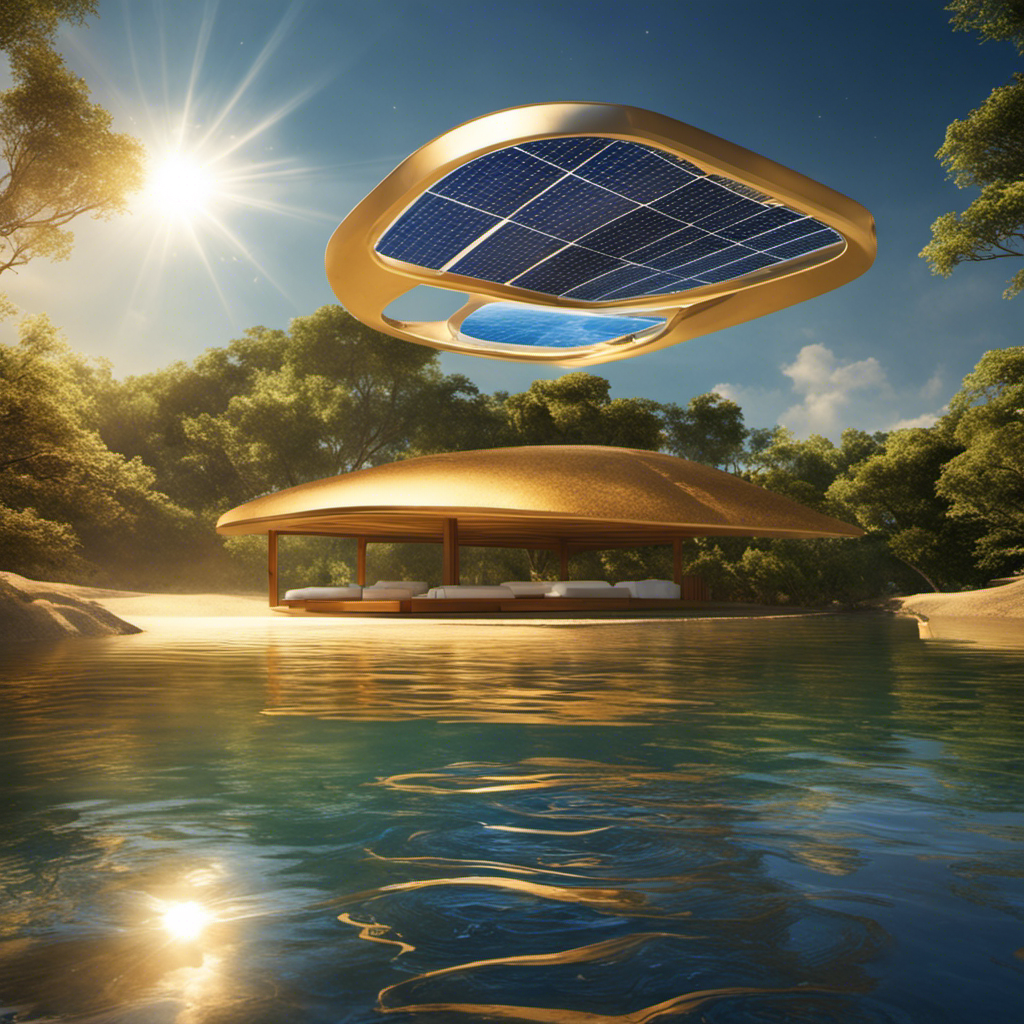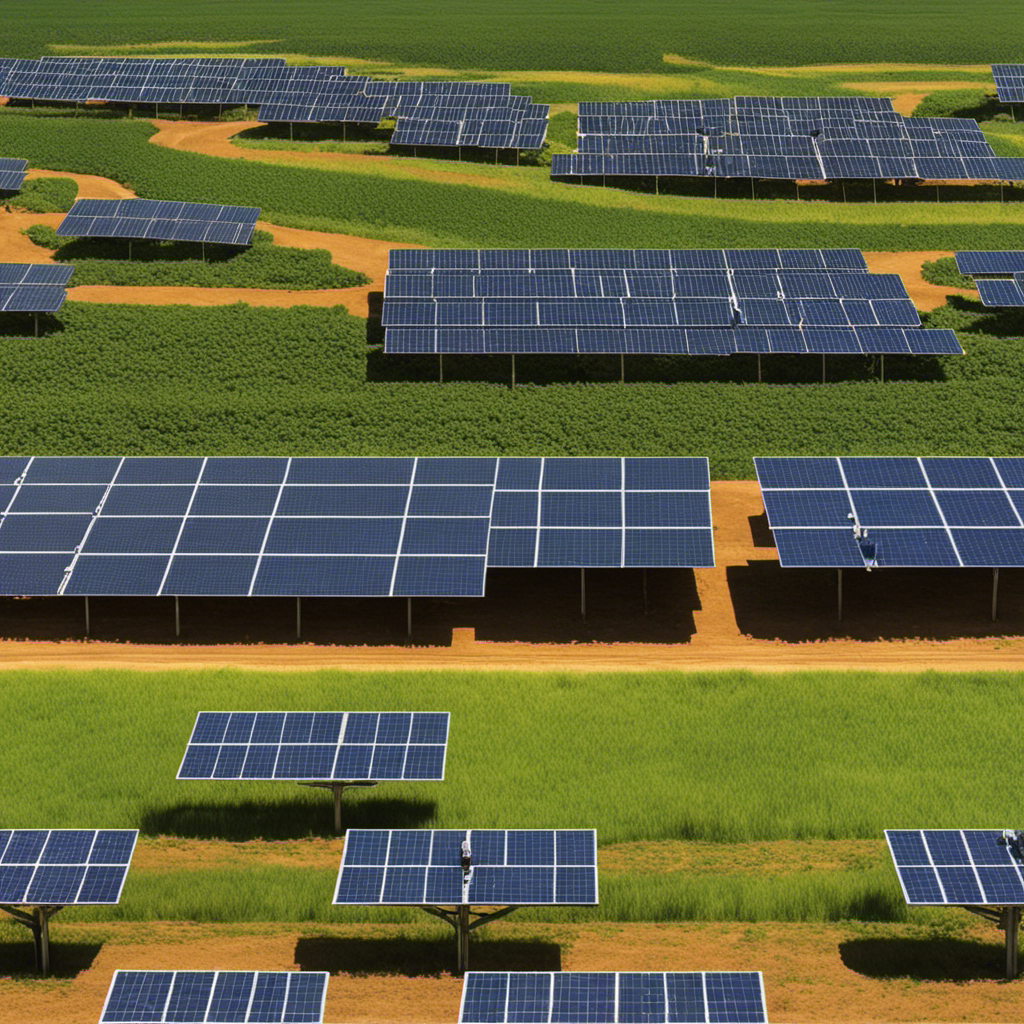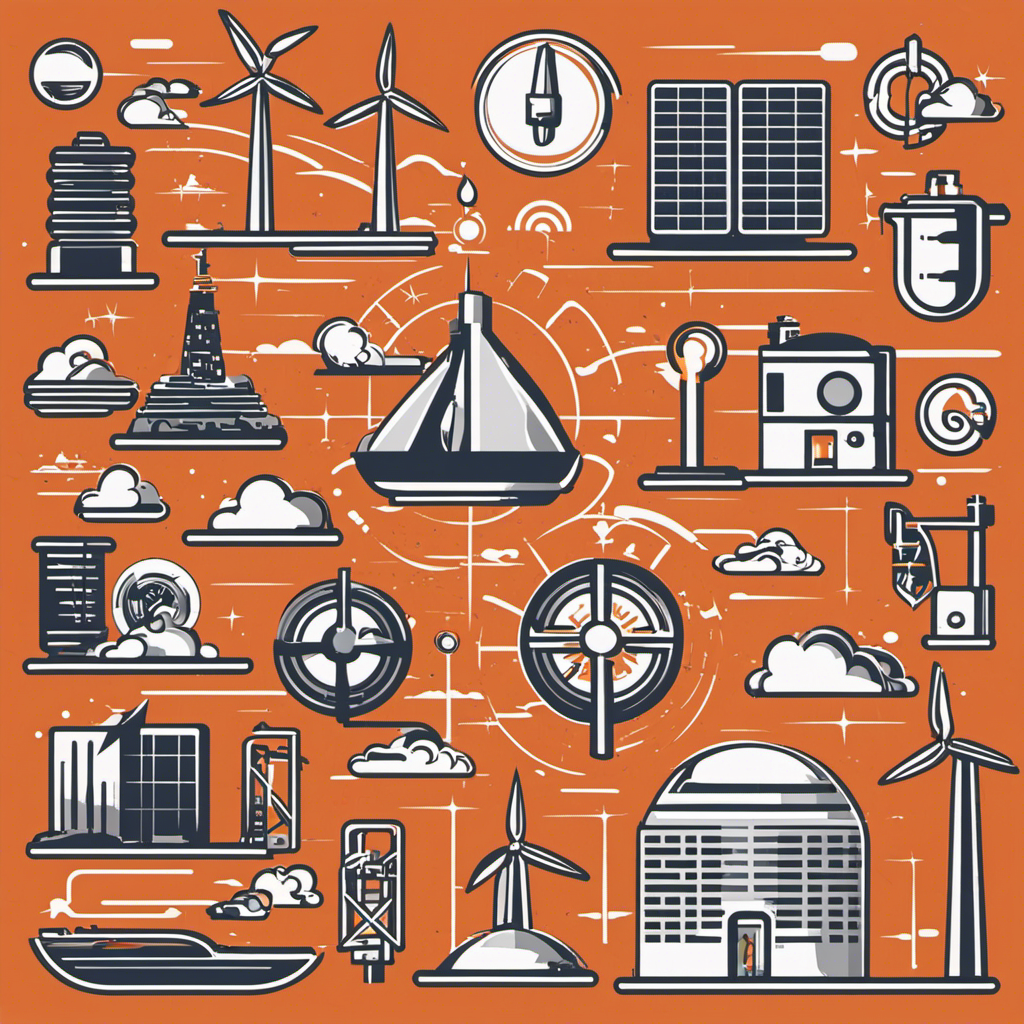Solar
How Does Solar Energy Get Into House

I’m gonna shed some light on how solar energy flows into your house.
Picture this: the sun’s rays beaming down onto those sleek solar panels, converting sunlight into electricity.
But it doesn’t stop there. This energy needs to be transformed into a usable form, which is where the inverter comes in.
And to ensure you have power even when the sun goes down, batteries store the excess energy.
Finally, the electrical system seamlessly integrates it all, bringing that solar power right into your home.
Key Takeaways
- Solar panels capture sunlight and convert it into DC electricity.
- Inverters transform DC electricity into AC electricity for home use.
- Excess electricity can be sent back to the grid through net metering systems.
- Batteries store excess electricity generated by solar panels for use during low sunlight periods.
The Basics of Solar Energy Conversion
I can explain how solar energy is converted into usable electricity for my home.
The process begins with solar panels, which are installed on the roof to capture sunlight. These panels contain photovoltaic cells that convert sunlight into direct current (DC) electricity.
The efficiency of solar energy conversion varies depending on factors such as the quality of the panels and the amount of sunlight received.
Once the solar panels generate DC electricity, it’s sent to an inverter, which converts it into alternating current (AC) electricity that can be used to power electrical appliances in the home.
To ensure efficient distribution of solar energy, a net metering system is often used. This system allows excess electricity to be sent back to the grid, while also allowing the home to draw electricity from the grid when solar energy production is low.
Overall, solar energy efficiency and distribution play crucial roles in harnessing the power of the sun for residential use.
Harnessing Sunlight: How Solar Panels Work
I can’t help but be amazed at how solar panels convert sunlight into usable electricity for my home. The process starts with the solar cells within the panels, which are made of semiconductor materials like silicon. When sunlight hits these cells, it excites the electrons, causing them to flow and create an electric current. This current is then captured and converted into usable electricity through an inverter.
When it comes to solar panel efficiency, it refers to how well the panels can convert sunlight into electricity. Factors like the type of cells, temperature, and shading can affect efficiency. Higher efficiency means more electricity can be generated from the same amount of sunlight.
As for solar energy storage, it’s an essential aspect of a solar-powered system. Excess electricity generated during the day can be stored in batteries for later use, such as during cloudy days or at night when there’s no sunlight. This allows for a reliable and consistent power supply even when sunlight isn’t available.
Overall, solar panels are incredible devices that efficiently convert sunlight into usable electricity, providing a clean and sustainable energy source for my home.
From Panels to Power: the Inverter and Its Role
The inverter is a crucial component of the solar panel system as it converts the captured electric current into usable electricity for my home. Without it, the direct current (DC) produced by the solar panels would be useless.
Here’s why inverter technology plays a vital role in the process:
-
Power Conversion: The inverter converts the DC electricity into alternating current (AC), which is the type of electricity used in homes and businesses.
-
Efficiency: Inverter technology has improved significantly over the years, resulting in higher power conversion efficiency. This means that more of the solar energy is effectively converted into usable electricity, maximizing the system’s overall performance.
-
Monitoring: Advanced inverters often come equipped with monitoring capabilities, allowing homeowners to track their energy production and consumption in real-time.
-
Grid Compatibility: Inverters enable solar panel systems to be connected to the electrical grid, allowing excess energy to be fed back into the grid and potentially earn credits or compensation.
Storing Solar Energy: The Importance of Batteries
Batteries play a vital role in storing the electricity generated by my solar panel system for later use. Battery efficiency and capacity are crucial for optimizing the performance and reliability of my solar energy system.
Battery efficiency refers to how effectively the battery can convert and store the energy it receives from the solar panels. It’s important to choose batteries with high efficiency to ensure that I can store as much energy as possible.
Battery capacity, on the other hand, refers to the amount of energy that a battery can store. The higher the battery capacity, the more energy I can store and use during periods of low solar generation.
By maximizing battery efficiency and capacity, I can ensure that I’ve a reliable and sustainable source of energy even when the sun isn’t shining.
This leads us to the next section, where I’ll discuss the integration of solar energy into my electrical system indoors.
Bringing Solar Energy Indoors: The Electrical System Integration
Bringing solar power indoors involves integrating the electrical system to ensure a seamless flow of renewable energy throughout my home. This process requires careful planning and installation to maximize the benefits of solar energy. Here are four key steps in integrating the electrical system for solar power:
-
Evaluate electrical wiring: It’s crucial to assess the existing electrical system’s capacity and condition. Upgrading wiring may be necessary to handle the additional energy generated by solar panels.
-
Install a solar inverter: A solar inverter converts the direct current (DC) produced by the solar panels into alternating current (AC) that can be used to power appliances and devices in the home.
-
Connect to the main electrical panel: The solar inverter should be connected to the main electrical panel to ensure the seamless integration of solar power with the utility grid.
-
Monitor energy consumption: Implementing energy monitoring systems allows for better management of electricity usage, helping to optimize energy consumption and minimize waste.
Frequently Asked Questions
How Much Does a Solar Energy System for a House Generally Cost?
Generally, the cost of a solar energy system for a house can vary depending on several factors. These factors include:
- The size of the system
- The type of solar panels used
- The complexity of the installation process
- Any additional equipment or services required
It’s important to consider these factors when determining the overall cost.
Additionally, factors such as location, available incentives, and financing options can also impact the cost of installing a solar energy system for your house.
What Are the Environmental Benefits of Using Solar Energy in a House?
Using solar energy in a house has numerous environmental benefits. Solar power is a renewable energy source, meaning it’s sustainable and doesn’t deplete natural resources. By harnessing the sun’s energy, we reduce our dependence on fossil fuels, which have a significant environmental impact.
Solar panels produce clean electricity, reducing greenhouse gas emissions and air pollution. Additionally, solar energy systems require minimal water for operation, conserving this valuable resource.
Overall, solar energy is a vital solution for a greener and more sustainable future.
Can Solar Panels Store Excess Energy for Use During Nighttime or Cloudy Days?
Yes, solar panels can store excess energy for use during nighttime or cloudy days. This is achieved through the use of battery storage systems.
These batteries are charged during the day when the solar panel system is generating more electricity than the house is consuming. The stored energy can then be used during periods of low solar panel efficiency, such as at night or on cloudy days.
It’s important to note that the ability to store excess energy depends on the type of system installed, with grid-tied systems being more commonly used for this purpose than off-grid systems.
How Long Does It Take to Install a Solar Energy System in a House?
Installing a solar energy system in a house involves several factors that can affect the time it takes. These include:
- The size of the system
- The complexity of the installation
- The availability of materials and labor
Additionally, the cost of installation and the maintenance requirements should be considered.
It’s important to consult with a professional to assess the specific needs of your house and to ensure a proper installation that maximizes the efficiency and effectiveness of solar energy utilization.
Are There Any Government Incentives or Tax Credits Available for Installing a Solar Energy System in a House?
Government incentives and tax credits can significantly reduce the cost of installing a solar energy system in your house. These financial benefits act as a ray of sunshine, encouraging homeowners to embrace renewable energy.
With government incentives, such as rebates and grants, you can recoup a portion of your initial investment. Additionally, tax credits allow you to deduct a percentage of the system’s cost from your taxes.
Overall, these incentives make solar power more accessible and affordable for homeowners.
Conclusion
In conclusion, the incredible process of how solar energy gets into your house is truly mind-blowing.
From harnessing sunlight through solar panels, to converting it into usable electricity with the help of inverters, and even storing the excess energy in batteries for later use, it’s like having a mini power plant right at your fingertips.
And let’s not forget the seamless integration of this clean energy into your electrical system, making your home a beacon of sustainability.
It’s a technological marvel that’s revolutionizing the way we power our homes.
Solar
Which Of The Following Are Disadvantages Of Solar Energy

Whoa there! Before you hop on the solar energy trend, let’s carefully examine its disadvantages.
As an energy analyst, I’ll give you the lowdown on the disadvantages of solar energy. Brace yourself for:
- High initial costs
- Dependence on sunlight
- Intermittent energy production
- Limited storage capacity
- Environmental impact
Buckle up, because we’re about to dive into the nitty-gritty details.
Key Takeaways
- High initial costs: Solar energy installation can be expensive, which can be a significant barrier for individuals and businesses. It may take several years to recoup the initial investment, and long-term benefits need to be weighed against the high upfront costs.
- Dependence on sunlight: Solar energy is only available during daylight hours and can be affected by weather conditions. This reliance on sunlight raises concerns about reliability and can lead to challenges for grid integration due to the intermittent availability of solar energy.
- Intermittent energy production: Solar energy production fluctuates due to sunlight availability and weather conditions, creating instability in the electrical grid. Sudden drops in power output can lead to imbalances in supply and demand, requiring backup power sources and increasing costs for grid operators.
- Limited storage capacity: Storage capacity is crucial in addressing the limitations of solar power. While advancements in energy storage aim to improve efficiency and capacity, the limited storage capacity of solar energy remains a challenge. Excess solar energy can be stored, but the need for backup power and energy storage adds complexity and cost to the system.
High Initial Costs
I’m concerned about the high initial costs of solar energy.
While solar energy has numerous long-term benefits, such as reducing greenhouse gas emissions and providing a renewable source of electricity, the upfront expenses can be a significant barrier for many individuals and businesses.
The installation of solar panels, inverters, and other necessary components can be quite expensive, making it difficult for some to afford the transition to solar energy. Additionally, the cost effectiveness of solar energy depends on various factors such as location, available sunlight, and government incentives.
Despite the long-term savings on electricity bills, it may take several years to recoup the initial investment. It’s crucial to consider these financial aspects before deciding to switch to solar energy, as the long-term benefits need to be weighed against the high upfront costs.
Dependence on Sunlight
The dependence on sunlight means that solar energy may not be available during cloudy or nighttime conditions. This can lead to reliability concerns, as the availability of solar energy is dependent on weather conditions and time of day. Solar panels require direct sunlight to generate electricity, and when sunlight is limited, the energy production decreases. This can pose challenges for grid integration, as the grid needs a constant and reliable source of energy to meet the demand. To illustrate the disadvantages of solar energy, I have provided a table below that highlights some of the key drawbacks:
| Disadvantages of Solar Energy | Description | Implications |
|---|---|---|
| Dependence on Sunlight | Solar energy is only available during daylight hours and can be affected by weather conditions. | Reliability concerns and challenges for grid integration. |
| High Initial Costs | The installation and equipment costs for solar energy systems can be expensive. | Financial barriers for widespread adoption. |
| Land and Space Requirements | Solar panels require a significant amount of space for installation, which can be a limitation in densely populated areas. | Land usage conflicts and limited deployment options. |
Intermittent Energy Production
Intermittent energy production can result in fluctuations in power supply and potential disruptions to the electrical grid. Solar energy, while a renewable and clean source of power, is subject to the limitations of sunlight availability. This means that solar panels can only generate electricity during daylight hours, and their output is affected by weather conditions and seasonal variations. These grid integration challenges pose significant disadvantages for solar energy.
The intermittent nature of solar energy production can create instability in the electrical grid, as sudden drops in power output can lead to imbalances in supply and demand. This can result in blackouts or the need for backup power sources to compensate for the fluctuations. Additionally, the reliance on sunlight means that solar energy isn’t consistently available, which can limit its reliability as a primary source of electricity.
Furthermore, the impact of intermittent energy production on electricity prices can’t be ignored. The unpredictability of solar energy output can lead to higher costs for grid operators, as they need to maintain backup power sources and invest in energy storage technologies to mitigate the fluctuating power supply. These additional expenses can ultimately be passed on to consumers in the form of higher electricity prices.
Limited Storage Capacity
As a result, storage capacity becomes a critical factor in addressing the limitations of solar power.
While solar energy is a clean and renewable source, its intermittent nature poses challenges in terms of energy supply.
Storage technology advancements play a crucial role in overcoming this drawback. These advancements aim to improve the efficiency and capacity of energy storage systems, allowing excess solar energy to be stored and used during periods of low or no sunlight.
Additionally, grid integration is another solution being explored. By connecting solar power systems to the electrical grid, excess energy can be fed back into the grid, reducing the need for storage.
This integration enables a more balanced and reliable energy supply, enhancing the overall effectiveness of solar energy as a sustainable option.
Environmental Impact
I believe it’s crucial to consider the environmental impact when discussing solar power. While solar energy is often praised for its clean and renewable nature, it isn’t without its drawbacks. Here are some important points to consider:
-
Carbon footprint: Solar panels themselves have a relatively low carbon footprint compared to fossil fuel sources. However, the production and disposal of solar panels can contribute to greenhouse gas emissions. It’s important to ensure that the manufacturing process is as sustainable as possible.
-
Ecosystem disruption: The installation of large-scale solar farms can disrupt natural habitats and ecosystems. Clearing land for solar panel installation can lead to the displacement of wildlife and destruction of native plants. Proper planning and consideration of biodiversity are essential to minimize these impacts.
It is essential that we carefully evaluate the environmental consequences of solar energy alongside its benefits to ensure a sustainable and responsible transition to renewable energy sources.
Frequently Asked Questions
How Does Solar Energy Compare to Other Renewable Energy Sources in Terms of Initial Costs?
In terms of initial costs comparison, solar energy is often seen as a more cost-effective option compared to other renewable energy sources. A cost effectiveness analysis reveals its potential for long-term savings and sustainability.
Are There Any Ways to Mitigate the Dependence of Solar Energy on Sunlight?
There are ways to enhance the efficiency of solar panels and generate solar energy without relying solely on sunlight. Exploring alternatives such as dual-axis tracking systems and using mirrors or lenses can increase the overall performance of solar energy systems.
How Does Intermittent Energy Production From Solar Panels Affect the Overall Reliability of the Energy Grid?
Intermittent energy production from solar panels poses reliability challenges for grid integration. The variability of sunlight can lead to fluctuations in energy supply, requiring backup systems and storage solutions to ensure a stable electricity grid.
What Are the Limitations and Challenges Associated With Storing Excess Solar Energy for Long Periods of Time?
Storing excess solar energy for long periods of time presents challenges. The limitations arise from the need for efficient and cost-effective storage solutions. These challenges are important to consider when evaluating the feasibility of solar energy as a reliable source.
What Are the Different Aspects of Environmental Impact That Should Be Considered When Evaluating Solar Energy?
When evaluating solar energy, it is important to consider its environmental impact. This includes factors such as land use, water consumption, and the production of hazardous materials. Evaluating these aspects helps determine the sustainability of solar energy.
Conclusion
While solar energy undoubtedly has its benefits, it’s important to acknowledge its drawbacks as well. High initial costs, dependence on sunlight, intermittent energy production, limited storage capacity, and environmental impact are all factors that need to be considered.
It’s crucial to approach the topic of solar energy with objectivity, analytical thinking, and an informative mindset. By understanding the disadvantages, we can make informed decisions about its implementation and work towards finding solutions to overcome these challenges.
Solar
Solar Energy And Water Are Known As What

As someone who is passionate about sustainability and always looking for new solutions, I am excited to present the exciting combination of solar energy and water.
These two powerful forces have merged to create something truly extraordinary. Together, they form a harmonious synergy that holds immense potential for our future.
In this article, we will explore the boundless possibilities and incredible benefits that arise when solar energy and water join forces.
Brace yourself for a journey that will leave you inspired and eager to embrace this remarkable combination.
Key Takeaways
- Solar energy and water combination provides a sustainable and cost-effective solution to global water scarcity.
- Solar irrigation increases agricultural productivity and reduces the strain on traditional energy sources for irrigation.
- Solar hydro integration maximizes energy production by combining solar panels and hydropower systems.
- Solar energy and water combination offer advantages such as reduction in reliance on fossil fuels, wide range of applications, and contribution to combating climate change.
The Synergy of Solar and Water
I’m amazed at the synergy between solar energy and water. The combination of these two powerful forces has the potential to revolutionize the way we address two critical challenges: desalination and irrigation.
Solar desalination is a process that uses solar energy to remove salt and impurities from seawater, making it safe and suitable for drinking and agricultural purposes. This technology offers a sustainable and cost-effective solution to the global water scarcity problem.
Similarly, solar irrigation utilizes solar panels to power water pumps, allowing farmers to efficiently water their crops and increase productivity. By harnessing the abundant energy of the sun, we can alleviate the strain on traditional energy sources and ensure a more sustainable and environmentally friendly future for water and agriculture.
Harnessing Solar-Hydro Power
I can harness the power of the sun and water together to generate electricity. Solar hydro integration is a promising technology that combines the benefits of both solar energy and hydropower. Here are four reasons why I believe it’s the future of solar hydro systems:
-
Increased efficiency: By combining solar panels with hydropower systems, we can maximize energy production throughout the day. Solar panels generate electricity during daylight hours, while hydropower plants can store excess energy and release it when needed.
-
Renewable energy storage: Solar hydro integration allows us to store excess energy in water reservoirs. This stored energy can be released during peak demand periods, ensuring a steady supply of renewable electricity.
-
Water conservation: Solar hydro systems can reduce the amount of water needed for hydropower generation. By using solar energy during non-peak hours, we can preserve water resources and minimize the ecological impact of traditional hydropower systems.
-
Scalability: Solar hydro integration is a flexible solution that can be implemented on various scales. From small-scale projects for residential use to large-scale installations for industrial purposes, this technology has the potential to meet diverse energy needs.
The future of solar hydro systems looks bright, as this innovative approach offers a sustainable and reliable source of electricity while leveraging the power of the sun and water.
Advantages of Solar Energy and Water Combination
Combining the power of the sun and water offers numerous advantages for generating clean and renewable electricity.
Solar water systems have proven to be highly efficient in harnessing the energy from the sun and integrating it with water to produce electricity. One major advantage of this combination is the abundance and availability of both solar energy and water. The sun provides an unlimited source of energy, while water is readily accessible in many parts of the world.
Additionally, solar water integration is a sustainable solution that reduces reliance on fossil fuels and helps combat climate change. The efficiency of solar water systems makes them a cost-effective option for generating electricity, as they require minimal maintenance and have a long lifespan.
With these advantages, solar-hydro energy solutions have a wide range of applications in various sectors, from agriculture to residential and commercial buildings.
Applications of Solar-Hydro Energy Solutions
One major application of solar-hydro energy solutions is in the agricultural sector, where it can provide a sustainable and cost-effective source of electricity for irrigation systems. This integration offers numerous benefits, such as:
-
Increased energy efficiency: Solar-hydro systems optimize the use of solar energy to power water pumps, reducing reliance on fossil fuels and reducing carbon emissions.
-
Enhanced water management: By harnessing solar energy, farmers can efficiently pump water from wells or rivers to irrigate their crops, ensuring adequate water supply for sustainable agriculture.
-
Economic empowerment for rural communities: Solar-hydro systems provide reliable electricity for irrigation, enabling farmers to increase crop yields and income, leading to improved livelihoods and economic growth.
-
Future prospects of solar water integration: As technology advances, solar-hydro systems continue to evolve, becoming more efficient and affordable. This opens up opportunities for wider adoption, benefiting more rural communities and contributing to sustainable development.
Solar-hydro energy solutions have immense potential to transform agriculture in rural communities, offering a promising future for solar water integration.
Overcoming Challenges in Solar-Water Technologies
To address obstacles in solar-water technologies, I’ve focused on enhancing the efficiency and affordability of existing systems. One area of advancement that has shown great promise is solar desalination. This process uses solar energy to remove salt and other impurities from seawater, making it suitable for drinking and irrigation. By optimizing the design and using innovative materials, we can significantly improve the efficiency of solar desalination systems, making them more accessible and cost-effective.
Another key aspect is improving solar water storage. The intermittent nature of solar energy poses a challenge for providing a consistent water supply. By developing efficient and affordable storage solutions, we can ensure a continuous water supply even when the sun isn’t shining. This can be achieved through the use of advanced battery technologies or by implementing innovative methods of water storage, such as underground reservoirs or elevated tanks.
Frequently Asked Questions
What Is the Current Global Capacity of Solar Energy and Water Combination?
The current global capacity of solar hydro capacity, which combines solar energy and water, is not known without the context of the question. However, it has the potential to meet the increasing global energy demand.
How Does Solar-Hydro Power Compare to Other Renewable Energy Sources?
Solar-hydro power, with its remarkable combination of solar energy and water, is an absolute game-changer in the renewable energy sector. When compared to wind energy, it boasts higher efficiency and offers a more reliable power generation solution.
What Are the Potential Environmental Impacts of Solar-Hydro Energy Solutions?
Potential environmental impacts of solar-hydro energy solutions include changes to aquatic ecosystems, water quality, and fish habitats. Research and development are essential to understand and mitigate these impacts, ensuring sustainable and responsible use of this renewable energy source.
Are There Any Limitations to the Applications of Solar-Hydro Energy Solutions?
There are limitations to the applications of solar-hydro energy solutions, but the future prospects are promising. It’s important to consider factors such as geographical limitations, cost, and technology advancements for widespread implementation.
What Are the Technological Advancements That Have Helped Overcome Challenges in Solar-Water Technologies?
Technological advancements have helped overcome challenges in solar-water technologies. By improving efficiency, storage, and scalability, we can harness solar energy to power water-related processes more effectively, making it an increasingly viable and sustainable solution.
Conclusion
So there you’ve it, folks! The incredible combination of solar energy and water, or what I like to call the dynamic duo, is revolutionizing the way we power our world.
With their powers combined, they create a renewable energy source that’s clean, efficient, and limitless. It’s like having your own personal superhero team fighting for a greener future.
So let’s embrace this amazing synergy and harness the power of the sun and water to create a brighter and more sustainable world for generations to come.
Solar
In Which Kind Of Reference Work Would You Be Most Likely To Find Information About Solar Energy

Where should one look to find information about solar energy?
Well, in my experience, the most likely place to find such knowledge is in an encyclopedia. These comprehensive reference works provide a wealth of information on various subjects, including the fascinating world of solar energy.
So, if you’re looking to expand your understanding of this renewable energy source, an encyclopedia might just be the perfect starting point.
Key Takeaways
- Encyclopedia and Research Database: Provides comprehensive knowledge on solar energy, including its advantages, disadvantages, history, and development.
- Technical Manual: Offers detailed information on technical specifications, installation process, safety procedures, troubleshooting guides, and maintenance tips for solar energy systems.
- Academic Journal: Keeps users updated on the latest research and advancements in renewable energy, including technological innovations, policy impact, and potential solutions.
- Government Publication: Provides reliable data on renewable energy policies and initiatives, including incentives, funding programs, regulatory frameworks, and real-life examples of successful projects.
Encyclopedia
I can find information about solar energy in an encyclopedia. An encyclopedia is a comprehensive reference work that covers various topics in a systematic manner.
When it comes to solar energy, an encyclopedia provides a wealth of knowledge about its advantages and disadvantages, as well as its history and development.
The advantages of solar energy include its renewable nature, as it relies on the sun’s energy, which is abundant and freely available. It’s also a clean source of energy, producing no harmful emissions.
However, there are some disadvantages to consider, such as the initial high cost of installation and the intermittent nature of solar power.
An encyclopedia would also provide information about the history and development of solar energy, tracing its origins back to ancient civilizations and its technological advancements over the years.
Research Database
In my opinion, a research database is the best place to find data and studies on solar energy. Research databases provide access to a wide range of scholarly articles that have been peer-reviewed and are therefore considered reliable sources of information.
Here are a few reasons why I believe research databases are the ideal resource for finding information on solar energy:
-
Access to a vast array of scholarly articles: Research databases contain a multitude of scholarly articles that have been published in reputable journals. These articles are written by experts in the field and undergo a rigorous review process to ensure accuracy and quality.
-
Up-to-date information: Research databases often provide the most current information on solar energy. Researchers regularly contribute new studies and findings, allowing users to stay informed on the latest developments in the field.
Overall, research databases offer a comprehensive and reliable collection of scholarly articles on solar energy, making them an invaluable resource for anyone seeking in-depth and up-to-date information on the topic.
Technical Manual
As a researcher, I find technical manuals to be an invaluable resource for understanding the intricacies of solar energy systems. These manuals provide comprehensive information about the technical specifications and installation process of solar energy systems. They offer detailed instructions on how to properly set up and maintain the various components of these systems, such as solar panels, inverters, and batteries.
Technical manuals also outline the safety procedures and precautions that need to be followed during the installation process. Additionally, these manuals provide troubleshooting guides and maintenance tips to ensure the smooth operation and longevity of solar energy systems.
Academic Journal
Reading academic journals has been a valuable way for me to stay updated on the latest research and advancements in the field of renewable energy. Academic research plays a crucial role in driving innovation and progress in the renewable energy sector. The findings and insights published in these journals provide a comprehensive understanding of the current state of renewable energy and offer potential solutions to existing challenges.
In terms of renewable energy advancements, academic journals cover a wide range of topics, including:
-
Technological innovations: These journals delve into the latest advancements in solar panel efficiency, energy storage systems, and grid integration techniques.
-
Policy and regulatory frameworks: Academic research explores the impact of policies and regulations on renewable energy adoption and analyzes strategies for overcoming barriers.
Government Publication
I find government publications to be a valuable source of information on renewable energy policies and initiatives. These publications provide comprehensive and reliable data that can be used to understand the current landscape of renewable energy and the government’s efforts to promote its adoption. Government policies play a crucial role in shaping the renewable energy sector, and staying informed about these policies is essential for anyone interested in the field. Whether it’s incentives for solar panel installations or regulations on wind farm development, government publications provide the latest information on these initiatives. The table below highlights some key aspects covered in government publications related to renewable energy:
| Key Aspects | Description |
|---|---|
| Policy Goals | Objectives and targets set by the government for renewable energy |
| Incentives | Financial or regulatory incentives provided to promote renewable energy |
| Funding Programs | Grants, loans, and funding opportunities for renewable energy projects |
| Regulatory Framework | Laws and regulations governing the development and operation of renewable energy |
| Success Stories | Case studies and examples of successful renewable energy projects |
Frequently Asked Questions
What Are the Economic Benefits of Using Solar Energy?
The economic benefits of using solar energy include increased energy savings, reduced electricity bills, and potential income from selling excess power back to the grid. Additionally, solar energy has a positive environmental impact by reducing greenhouse gas emissions and dependence on fossil fuels.
How Can Solar Energy Be Integrated Into Existing Power Grids?
When exploring grid integration challenges and renewable energy integration, I often turn to scientific journals or online databases. These references provide thorough and objective information on how solar energy can be integrated into existing power grids.
Are There Any Potential Health Risks Associated With Solar Energy?
I would search for information about potential health risks and environmental impact of solar energy in scientific journals and databases. These sources provide thorough and objective research on the subject matter.
What Is the Current State of Solar Energy Adoption Worldwide?
When looking for information about solar energy, I would most likely find it in a scientific encyclopedia or a specialized reference book on renewable energy sources. These sources provide comprehensive and up-to-date information on current solar technology advancements and government initiatives for solar energy.
How Can Individuals or Businesses Finance the Installation of Solar Panels?
To find information about financing options and government incentives for installing solar panels, I would look in a reference work like a renewable energy handbook or a guide to sustainable living.
Conclusion
After an exhaustive and enlightening exploration of various reference works, it becomes abundantly clear that the most suited vessel for uncovering the secrets of solar energy lies within the sacred pages of an Encyclopedia.
Its vast expanse of knowledge, meticulously curated by experts in the field, offers a comprehensive and coherent understanding of this celestial power source.
So, dear seekers of solar enlightenment, venture forth into the realm of encyclopedic wisdom, and let the sun shine upon your intellectual endeavors.
-

 Sustainable Supply Chain Management4 months ago
Sustainable Supply Chain Management4 months agoManagEnergy Acquires GPST2030.org Domain to Strengthen Commitment to Sustainable Transport
-

 Wind Energy5 months ago
Wind Energy5 months agoHow Much Oil Does It Take To Lubricate A Wind Turbine
-

 Electric Motorbike3 months ago
Electric Motorbike3 months agoCalifornia Electric Motorcycle Laws: A Comprehensive Guide to Riding Safely
-

 Solar4 months ago
Solar4 months agoIn 2009, About What Percent Of U.S. Energy Consumption Was Supplied By Solar Energy
-

 Electricity Vehicle3 months ago
Electricity Vehicle3 months agoThe Future of Electric Vehicles: Trends and Innovations to Watch
-

 Wind Energy3 months ago
Wind Energy3 months agoRevolutionizing Highways: Wind Turbines Take the Road to Renewable Energy
-

 Solar4 months ago
Solar4 months agoWhy Should We Use Solar Energy Instead Of Fossil Fuels
-

 Solar4 months ago
Solar4 months agoHow Much Solar Energy To Go Off The Grid


















